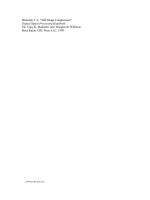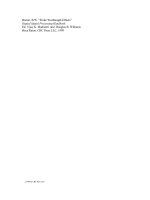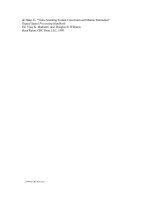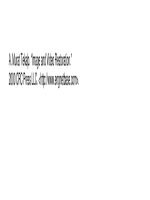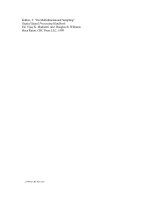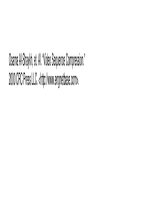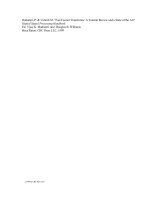elliott, d. f. (1987) handbook of digital signal processing - engineering applications
Bạn đang xem bản rút gọn của tài liệu. Xem và tải ngay bản đầy đủ của tài liệu tại đây (36.83 MB, 1,022 trang )
Handbook
of
Digital
Signal
Processing
Engineering Applications
This page intentionally left blank
Handbook
of
Digital
Signal
Processing
Engineering
Applications
Edited
by
Douglas
F.
Elliott
Rockwell
International Corporation
Anaheim,
California
ACADEMIC
PRESS,
INC.
Harcourt
Brace
Jovanovich,
Publishers
San
Diego
New
York
Berkeley Boston
London Sydney
Tokyo
Toronto
COPYRIGHT
©
1987
BY
ACADEMIC
PRESS,
INC.
ALL
RIGHTS
RESERVED
NO
PART
OF
THIS PUBLICATION
MAY BE
REPRODUCED
OR
TRANSMITTED
IN ANY
FORM
OR BY ANY
MEANS, ELECTRONIC
OR
MECHANICAL, INCLUDING
PHOTOCOPY,
RECORDING,
OR
ANY
INFORMATION
STORAGE
AND
RETRIEVAL SYSTEM, WITHOUT
PERMISSION
IN
WRITING FROM
THE
PUBLISHER
ACADEMIC PRESS, INC.
San
Diego, California 92101
United
Kingdom Edition published
by
ACADEMIC
PRESS LIMITED
24-28 Oval Road, London
NW1 7DX
Library
of
Congress
Cataloging
in
Publication
Data
Handbook
of
digital
signal
processing.
Includes
index.
1.
Signal
processing-Digital techniques-Handbooks,
manuals,
etc.
I.
Elliott,
Douglas
F.
TK5102.5.H32
1986
621.38'043
86-26490
ISBN
0-12-237075-9
(alk,
paper)
PRINTED
IN THE
UNITED
STATES
OF
AMERICA
89
90 91
98765432
Preface
Acronyms
and
Abbreviations
Notation
XI
xiii
xvii
Chapter
1
Transforms
and
Transform
Properties
DOUGLAS
F.
ELLIOTT
I.
Introduction
II.
Review
of
Fourier Series
III. Discrete-Time Fourier Transform
IV.
z-Transform
V.
Laplace Transform
VI.
Table
of
z-Transforms
and
Laplace Transforms
VII.
Discrete Fourier Transform
VIII.
Discrete-Time Random Sequences
IX.
Correlation
and
Covariance Sequences
X.
Power Spectral Density
XI.
Summary
References
1
2
6
16
24
27
27
41
45
50
51
53
Chapter
2
Design
and
Implementation
of
Digital
FIR
Filters
P.
P.
VAIDYANATHAN
I.
Introduction
55
II.
FIR
Digital Filter Preliminaries
56
HI.
FIR
Filter Design Based
on
Windowing
61
IV.
Equiripple
Approximations
for FIR
Filters
71
V.
Maximally Flat Approximations
for FIR
Filters
90
VI.
Linear
Programming Approach
for FIR
Filter Designs
95
VII. Frequency Transformations
in
FIR
Filters
100
VIII.
Two-Dimensional
Linear-Phase
FIR
Filter Design
and
Implementation
112
IX.
Recent Techniques
for
Efficient
FIR
Filter Design
118
X.
Other
Useful
Types
of FIR
Filters
136
XI.
Summary
146
Appendix
A.
Design Charts
for
Digital
FIR
Differentiators
and
Hilbert
Transformers
147
Appendix
B.
Program Listings
for
Linear-Phase
FIR
Filter Design
150
References
170
Chapter
3
Multirate
FIR
Filters
for
Interpolating
and
Desampling
FREDERIC
J.
HARRIS
I.
Introduction
II.
Characteristics
of
Bandwidth-Reducing
FIR
Filters
173
180
Contents
VI
Contents
HI.
Data Rate Reduction (Desampling)
by
1/Af
Filters
208
IV.
Heterodyne Processing
223
V.
Interpolating Filters
234
VI.
Architectural Models
for FIR
Filters
245
VII.
Summary
252
Appendix.
Windows
as
Narrowband Filters
253
References
286
Chapter
4
MR
Digital
Fitters
NAZIR
A.
PASHTOON
I.
Introduction
289
II.
Preliminaries
290
III. Stability
291
IV.
Digital Filter Realizations
295
V.
Frequency Domain Design
300
VI.
Analog Filter Design
and
Filter Types
306
VII.
Frequency Transformations
331
VIII.
Digital Filter Design Based
on
Analog Transfer Functions
332
IX.
Spectral Transformations
343
X.
Digital Filters Based
on
Continuous-Time Ladder Filters
344
XI.
Summary
353
Appendix.
HR
Digital Filter
CAD
Programs
355
References
355
Chapter
5
Low-Noise
and
Low-Sensitivity
Digital
Filters
P.
P.
VAIDYANATHAN
I.
Introduction
359
II.
Binary
Numbers—Representation
and
Quantization
361
III. Generation
and
Propagation
of
Roundoff Noise
in
Digital Filters
369
IV.
Dynamic Range Constraints
and
Scaling
373
V.
Signal-to-Roundoff-Noise
Ratio
in
Simple
HR
Filter Structures
378
VI.
Low-Noise
HR
Filter
Sections
Based
on
Error-Spectrum Shaping
387
VII.
Signal-to-Noise
Ratio
in
General Digital
Filter
Structures
395
VIII.
Low-Noise
Cascade-Form
Digital Filter Implementation
396
IX.
Noise Reduction
in the
Cascade
Form
by ESS 399
X.
Low-Noise Designs
via
State-Space
Optimization
402
XI.
Parameter Quantization
and
Low-Sensitivity
Digital Filters
412
XII. Low-Sensitivity Second-Order Sections
416
XIII. Wave Digital
Filters
419
XIV.
The
Lossless Bounded Real Approach
for the
Design
of
Low-
Sensitivity
Filter
Structures
434
XV.
Structural Losslessness
and
Passivity
443
XVI.
Low-Sensitivity All-Pass-Based Digital Filter Structures
444
XVII.
Digital All-Pass Functions
453
XVIII.
Orthogonal Digital Filters
458
XIX. Quantization
Effects
in FIR
Digital Filters
460
XX.
Low-Sensitive
FIR
Filters Based
on
Structural Passivity
465
XXI.
Limit Cycles
in HR
Digital Filters
469
References
475
Contents
vii
Chapter
6
Fast
Discrete
Transforms
PAT
YIP AND K.
RAMAMOHAN
RAO
I.
Introduction
II.
Unitary Discrete Transforms
III.
The
Optimum Karhunen
Loeve
Transform
IV.
Sinusoidal Discrete Transforms
V.
Nonsinusoidal Discrete Transforms
VI.
Performance Criteria
VII.
Computational Complexity
and
Summary
Appendix
A.
Fast
Implementation
of DCT via FFT
Appendix
B. DCT
Calculation Using
an FFT
Appendix
C.
Walsh-Hadamard
Computer Program
References
481
482
483
485
499
510
516
517
521
523
523
Chapter
7
Fast
Fourier
Transforms
DOUGLAS
F.
ELLIOTT
I.
Introduction
II.
DFTs
and
DFT
Representations
III.
FFTs
Derived
from
the MIR
IV.
Radix-2 FFTs
V.
Radix-3
and
Radix-6
FFTs
VI.
Radix-4
FFTs
VII.
Small-JVDFTs
VIII.
FFTs Derived
from
the
Ruritanian Correspondence (RC)
IX.
FFTs Derived
from
the
Chinese Remainder Theorem
X.
Good's
FFT
XL
Kronecker
Product Representation
of
Good's
FFT
XII. Polynomial Transforms
XIII.
Comparison
of
Algorithms
XIV.
FFT
Word Lengths
XV.
Summary
Appendix
A.
Small-AT
DFT
Algorithms
Appendix
B. FFT
Computer Programs
Appendix
C.
Radix-2
FFT
Program
Appendix
D.
Prime Factor Algorithm
(PFA)
Appendix
E.
Highly
Efficient
PFA
Assembly Language Computer Program
References
527
528
532
553
558
564
565
567
571
573
574
579
580
587
595
596
600
602
605
621
630
Chapter
8
Time
Domain
Signal
Processing
with
the DFT
FREDERIC
J.
HARRIS
I.
Introduction
II. The DFT as a
Bank
of
Narrowband Filters
III. Fast Convolution
and
Correlation
IV.
The DFT as an
Interpolator
and
Signal Generator
V.
Summary
References
633
639
666
683
698
698
viii
Contents
Chapter
9
Spectral
Analysis
JAMES
A.
CADZOW
I.
Introduction
II.
Rational Spectral Models
HI.
Rational Modeling: Exact Autocorrelation
Knowledge
IV.
Overdetermined
Equation Modeling Approach
V.
Detection
of
Multiple Sinusoids
in
White Noise
VI.
MA
Modeling: Time Series Observations
VII.
AR
Modeling: Time Series Observations
VIII.
ARMA Modeling: Time Series Observations
IX.
ARMA
Modeling:
A
Singular Value Decomposition Approach
X.
Numerical Examples
XI.
Conclusions
References
701
702
707
714
716
721
723
724
726
731
739
739
Chapter
10
Deconvolution
MANUEL
T.
SILVIA
I.
Introduction
II.
Deconvolution
and
LTI
Systems with
No
Measurement Noise
III.
Deconvolution
and the
Identification
of
DTLTI
Systems
with
Measurement
Noise
IV.
Fast
Algorithms
for
Deconvolution Problems
V.
Some Practical Applications
of
Deconvolution
VI.
Summary
Appendix
A.
References
for
Obtaining Computational Algorithms
Appendix
B.
Implementing
the
Levinson
or
Toeplitz
Recursion
Appendix
C.
Implementing
the
Lattice Form
of the
Levinson Recursion
References
741
746
760
766
777
784
785
786
787
787
Chapter
11
Time Delay Estimation
MANUEL
T.SILVIA
I.
Introduction
789
II.
Time Delay Estimation
for
Active Sensors
793
III. Time Delay Estimation
for
Passive Sensors
818
IV.
Cross-Correlation
and Its
Relationship
to the
Time Delay
Estimation Problem
833
V.
The
Implementation
of
Some Time Delay Estimation Algorithms
Using
the
Fast Fourier Transform
(FFT)
837
VI.
Algorithm Performance
844
VII.
Summary
853
References
853
Chapter
12
Adaptive
Filtering
NASIR
AHMED
I.
Introduction
II.
Some Matrix Operations
III.
A
Class
of
Optimal Filters
IV.
Least-Mean-Squares
(LMS) Algorithm
857
858
860
866
Contents
IX
V.
LMS
Lattice Algorithms
VI.
Concluding Remarks
Appendix.
Four
FORTRAN-77
Programs
References
882
888
889
896
Chapter
13
Recursive
Estimation
GENE
H.
HOSTETTER
I.
Introduction
II.
Least
Squares
Estimation
III. Linear Minimum Mean Square Estimation
IV.
Discrete
Kalman
Filtering Examples
V.
Extensions
VI.
Some Computational
Considerations
VII.
Summary
References
Chapter
14
Mechanization
of
Digital
Signal
Processors
LESTER
MINTZER
I.
Introduction
II.
Digital Machine Fundamentals
III.
The
Essence
of
Digital Signal Processing
IV.
Number
Representations
V.
Hardware Components
VI.
Microprogramming
VII.
Keeping Things
in
Perspective
VIII.
Distributed Arithmetic
IX.
Summary
References
899
900
908
915
922
929
938
938
941
942
947
947
950
959
963
964
972
972
Addendum
to
Chapter
3
Window
Generation
Computer
Program
FREDERIC
J.
HARRIS
975
Index
987
This page intentionally left blank
When
Academic Press approached
me
with
the
proposal that
I
serve
as
editor
of a
handbook
for
digital
signal processing,
I was
aware
of the
need
for
such
a
book
in my
work
in the
aerospace industry. Specifically,
I
wanted basic
digital
signal
processing principles
and
approaches described
in a
book
that
a
person with
a
standard engineering background could understand. Also,
I
wanted
the
book
to
cover
the
more advanced
approaches,
to
outline
the
advan-
tages
and
disadvantages
of
each approach,
and to
list references
in
which
I
could
find
detailed derivations
and
descriptions
of the
approaches that might
be
most
applicable
to
given implementation problems.
The
various authors
in
this volume have done
an
outstanding
job of ac-
complishing these
goals.
Coverage
of the
fundamentals alone makes
the
book
self-sufficient,
yet
many advanced techniques
are
described
in
readable,
descriptive prose without formal proofs. Detailing fundamental approaches
and
describing
other
available techniques provide
an
easily understandable
book containing information
on a
wide range
of
approaches.
For
example,
the
chapter
on
adaptive
filters
derives basic adaptive
filter
structures
and
provides
the
reader
with
a
background
to
"see
the
forest"
of
adaptive
filtering. The
chapter then describes various alternatives, including adaptive lattice struc-
tures
that
might
be
applicable
to
particular engineering problems. This
description
is
provided without
the
detailed derivations that
get one
"lost
in
the
trees."
Many
new
useful
ideas
are
presented
in
this handbook, including
new
finite
impulse
response (FIR)
filter
design techniques, half-band
and
multiplierless
FIR
filters,
interpolated
FIR
(IFIR)
structures,
and
error spectrum
shaping.
The
advanced digital
filter
design techniques provide
for
low-noise, low-
sensitivity, state-space,
and
limit-cycle
free
filters.
Filters
for
decimation
and
interpolation
are
described
from
an
intuitive
and
easily understandable
view-
point.
New
fast
Fourier transform
(FFT)
ideas include
in-place
and
in-order
mixed-radix
FFTs,
FFTs
computed
in
nonorthogonal
coordinates,
and
prime
factor
and
Winograd Fourier transform algorithms.
Transmultiplexing
discus-
sions
carefully
describe
how to
control crosstalk,
how to
satisfy
dynamic range
requirements,
and how to
avoid aliasing when resampling.
Using
an
over-
determined
set of
Yule-Walker
equations
is a key
concept described
for
reduc-
ing
data-induced
hypersensitivities
of
parameters
in
model-based spectral
estimation.
Tools
are
provided
for
understanding
the
basic theory,
physics,
Preface
xii
Preface
and
computational algorithms
associated
with
deconvolution
and
time delay
estimation. Recursive least squares adaptive
filter
algorithms
for
both lattice
and
transversal structures
are
compared
to
other
approaches,
and
their advan-
tage
in
terms
of
rapid convergence
at the
expense
of a
modest computational
increase
is
discussed.
Extensions
of
Kalman filtering include
square-root
filter-
ing.
The
simplicity
and
regularity
of
distributed arithmetic
are
lucidly described
and are
shown
to be
attractive
for
VLSI implementation.
There
is
some overlap
in the
material covered
in
various chapters,
but
readers
will
find
the
overlap helpful.
For
example*
in
Chapter
2
there
is an ex-
cellent
derivation
of
FIR
digital
filters
that provides
the
necessary
mathematical framework,
and in the
first
part
of
Chapter
3
there
is an
intuitive
explanation
of how
various
FIR
filter
parameters,
such
as
impulse response
length,
affect
the filter
performance. Similarly,
in
Chapter
9 the
Yule-Walker
equations
are
discussed
in the
context
of
spectral analysis, whereas
in
Chapter
10
these equations appear
from
a
different
viewpoint
in the
context
of
decon-
volution.
Many
applications
in
digital signal processing involve
the use of
computer
programs.
After
many discussions
the
chapter authors decided
to
include
useful
programs
and to
give
references
to
publications
in
which
related
pro-
gram
listings
can be
found.
For
example, Chapter
7
points
out
that
a
large
percentage
of
FFT
applications
are
probably best accomplished
with
a
radix-2
FFT,
and
such
an FFT is
found
in
Appendix
7-C.
However, Appendixes
7-D
and 7-E
present prime factor algorithms
designed
for IBM ATs and
XTs.
The
listing
in
Appendix
7-E is a
highly
efficient
1008-point
assembly
language
pro-
gram.
Other sources
for
FFTs
are
also listed
in
Appendix 7-B.
The
encouragement
of
Academic Press
was
crucial
to the
development
of
this
book,
and I
would like
to
thank
the
editors
for
their support
and
advice.
I
would
also
like
to
express
my
appreciation
to
Stanley
A.
White
for his
behind-
the-scenes contribution
as an
advisor,
and to
thank
all of the
chapter authors
for
their diligent
efforts
in
developing
the
book.
Finally,
I
would like
to
thank
my
wife,
Carol,
for her
patience regarding time
I
spent compiling, editing,
and
writing
several chapters
for the
book.
Isb
Least
significant
bit
msb
Most significant
bit
ADC
Analog-to-digital
converter
AGC
Automatic gain control
ALE
Adaptive line enhancer
AR
Autoregressive
ARMA
Autoregressive moving average
BP
Bandpass
BPF
Bandpass
filter
BR
Bounded real
BRO
Bit-reversed order
CAD
Computer-aided design
CCW
Counterclockwise
CO
Coherent gain
CMOS Complementary
metal-on-silicon
CMT
C-matrix
transform
CRT
Chinese remainder theorem
CSD
Canonic sign digit
DA
Distributed arithmetic
DAC
Digital-to-analog
converter
DCT
Discrete cosine transform
DFT
Discrete Fourier transform
DF2
Direct-form
2
DIP
Decimation-in-frequency
DIT
Decimation-in-time
DPCM Differential pulse code modulation
DRO
Digit-reversed order
DSP
Digital signal processing
DST
Discrete sine transform
DTFT
Discrete-time Fourier transform
DTLTI
Discrete-time linear time-invariant
DTRS
Discrete-time random sequence
DWT
Discrete Walsh transform
EFB
Error feedback
ENBW
Equivalent noise bandwidth
EPE
Energy packing
efficiency
ESS
Error-spectrum shaping
FDM
Frequency-division
(domain) multiplexing
FDST Fast discrete sine transform
FFT
Fast Fourier transform
FIR
Finite impulse response
GT
General orthogonal transform
HHT
Hadamard-Haar
transform
Acronyms
and
Abbreviations
XIV
Acronyms
and
Abbreviations
HPF
Highpass
filter
HT
Haar transform
IDFT
Inverse discrete Fourier transform
IDTFT
Inverse
discrete-time
Fourier
transform
IFFT
Inverse fast Fourier transform
IFIR
Interpolated
finite
impulse response
IIR
Infinite-duration impulse response
IQ
In-phase
and
quadrature
IT
Inverse transform; identity transform
KLT
Karhunen-Loeve
transform
KT
Kumaresan-Tufts
LBR
Lossless bounded real
LC
Inductance-capacitance
LDI
Lossless discrete integrator
LHP
Left
half-plane
LMS
Least-mean-square
LP
Lowpass
LPC
Linear predictive coding
LPF
Lowpass
filter
LS
Least squares
LSA
Least squares analysis
LSI
Large-scale
integration
LTI
Linear time-invariant
MA
Moving average
MAC
Multiplier-accumulator
MFIR
Multiplicative
finite
impulse response
MIR
Mixed-radix integer representation
MLMS
Modified least-mean-square
MMS
Minimum
mean-square
MP
McClellan-Parks
MSB
Mean-squared error
MSP
Most significant product
NO
Natural order
NTSC National Television Systems Committee
NTT
Number-theoretic transform
PFA
Prime factor algorithm
PROM Programmable read-only memory
PSD
Power spectrum density
PSR
Parallel-to-serial
register
QMF
Quadrature
mirror
filter
RAM
Random-access memory
RC
Ruritanian correspondence
RCFA
Recursive cyclotomic factorization algorithm
RHT
Rationalized
Haar
transform
RLS
Recursive least squares
ROM
Read-only memory
RRS
Recursive running
sum
RT
Rapid transform
SD
Sign digit
SDSLSI
Silicon-on-sapphire
large-scale integration
SER
Sequential regression
SFG
Signal-flow graph
SNR
Signal-to-noise ratio
Acronyms
and
Abbreviations
xv
SPR
Serial-to-parallel
register
SR
Shift
register
SRFFT
Split-register
fast Fourier transform
SSBFDM Single-sideband frequency-division multiplexing
ST
Slant transform
SVD
Singular value
decomposition
TDM
Time division (domain) multiplexed
VLSI
Very large-scale integration
WDF
Wave digital filter
WFTA Winograd Fourier transform algorithm
WHT
Walsh-Hadamard
transform
WSS
Wide-sense stationary
This page intentionally left blank
Symbol
Meaning
a—b
Give variable
a the
value
of
expression
b (or
replace
a by b)
a,
x,
Lowercase denotes
scalars
a,
x,
Underbar
denotes
a
random variable
a*,
x*,
The
complex conjugate
of a. x,
a
k
,
b
k
,
c
k
,
Filter
coefficients
a
k
Coefficients
for the
numerator polynomial
of a
transfer function, coefficients
of
corresponding difference equation
b
t
,
c
it
di,
y,
Elements
of
Jury's array
for
stability testing
b
Number
of
bits used
to
represent
the
value
of a
number (does
not
include
the
sign
bit)
b
k
Coefficients
of the
denominator
for
polynomial
of a
transfer function,
coeffi-
cients
in the
corresponding difference equation
c
Recursive least squares
scalar
divisor, initial state mean
c,
Scale factor
given
by
=
(1
if
i*OorN
Cj
~
UA/2
if/
=
OorN
cj(m)
Autocovariance
sequence
for the
discrete-time random sequence
xj(n)
where
cj(m)
=
E{[xJin)
-
n&xjin-m)
-
M
J*}
c
ty
(m)
Cross-covariance
sequence
for the
discrete-time random sequences
x(n)
and
y(n)
where
c^m)
=
E{[x(n)
-
n,][y(n-m)
-
M>
]*}
d
Discrimination factor
d(n),
g(n) Input output sequences
d(n)
Hilbert transform
of
d(ri)
[d{n),
jd(n)]
Analytic signal
d(s,n)
Data sequence where
s is
slow time index (identifies groups)
and n is
fast
time
index
(identifies position
in a
group)
e'
UT
Steady-state frequency domain contour
in the
z-plane
e(n)
Error sequence
/
Frequency
in
hertz (Hz)
/
0
Filter center frequency
/„
Passband
upper edge frequency
in
hertz
/,
Stopband
lower edge frequency
in
hertz
f
r
Stopband (rejection band) edge frequency
in
hertz
/,
Sampling frequency
in
hertz;/,
=
\/T
/,'
Resampling
frequency
/(z)
A
linear factor
(z -
re
3
*)
f'(z)
A
linear factor
(rz
-
e^)
g(n),
h(ri),
Time domain
scalars
h(n)
Filter impulse response, filter coefficient, data sequence window
h,(t)
Impulse response
of an
analog prototype
filter
Notation
XVIII
Notation
Symbol
i,
j, k, /,
m,
n
i
s
m
(modulo
«)
j
k
In
log
Iog
2
tn
t
n
q(k,s)
r
/•„("»)
s
m
u(n)
x,
x(n)
x(n),
y(n),
x(t)
x,(t)
x
x(ri)
*
y(n)
y(n)
A
A,,
A,
A © B
Arg[H(e^]
A
p
B
a
D
b(e**)
D(z)
DFTM«)]
DTFTLY(«)]
Integer indices
/
is
congruent
to m
(modulo
n),
i.e.,
i
=
In + m
where
/',
/, m, and n are
integers
Transform
sequence number, integer step index, selectivity parameter
Logarithm
to the
base
e
Logarithm
to the
base
10
Logarithm
to the
base
2
rth
multiplier
coefficient
Data
sequence number (time index), system dynamic order
Data
sequence from
filter
bank where
k is the
filter
index
and
s
is the
time
index
Magnitude
of a
complex number
(pole,
zero)
Autocorrelation sequence
for the
discrete-time random sequence
x(n)
where
r
x
,(m)
=
E[x(n)x*(n
-
m)]
Cross-correlation sequence
for the
discrete-time random sequences
x(n)
and
y_(ri)
where
r
ty
(m)
=
E[x(ri)y*(n
-
m)]
Laplace transform variable,
5 = a +
jui
Zeros
of the
inverse
Chebyshev
filters
10
otherwise
Unit
step sequence defined
by
u(ri)
=
Value
of
inductance
or
capacitance
Input sequence;
«th
data
sample
Discrete-time
random sequences
Time domain scalar-valued
function
at
time
t
Sampled function
Estimate
of the
random variable
x
The
convolution
of the
sequences
x(ri)
and
y(ri)
where
x(ri)
*
y(n)
=
x(m)y(n
-
m)
Output sequence
z-transform
independent variable,
z =
e
sT
,
but
used
in
this
book
for a
nor-
malized sampling period
of T = 1
unless otherwise indicated
Minimum
stopband
attenuation
Filter
passband
attenuation
in
decibels,
A
p
= - 20
log,
0
5,
Minimum
acceptable
filter
stopband attenuation
in
decibels,
A
r
= 20
log,
0
5
2
Bit
by bit
addition
of the
binary numbers
A and B
Steady-state
frequency
domain
phase
response
Maximum
allowable specified passband ripple
in
decibels
BPF
bandwidth (rad
s'
1
)
Chebyshev
polynomial
of
degree
n
(Chapter
4)
Distortion
function
The
desired
frequency
response
of a
digital
filter
Denominator polynomial
of a
transfer
function
The
discrete Fourier transform
of the
sequence
x(n)
The
discrete-time Fourier transform
of the
sequence
x(n)
Expected value, expectation
Approximation
error
spectrum
r
xf
(m)
s
Notation
xix
Symbol
Ei
%
Ei
F
F,,,(z~')
G(e'
a
),
H(e^),
,
G(z),
//(z),
G(z)
G,(z)
H
a
(ju>)
H(e
jur
)
\H(e
JtaT
)\
H(f)
Hi(z)
H(z)
H
a
(z)
//*
//(«)
7,
J,
K,
L,
M,
N
7(z)
«*)
Im[ ]
I
N
I
0
(x)
J
K
(A
)
M
N
N(z)
Q
Q[x(n)\
Re[
]
R
n
(u)
S,
x
(e
JU
)
W(e
i<j!
)
X(e
i<J
)
X(k)
X(z)
X'(z)
X
'(e
jt
*)
Meaning
Shorthand
notation
for the
matrices
of
exponents defined
by
W&
Wfr
Analog frequency
in
hertz
A
causal approximant
to
predictor
z
Transform
domain
scalars
An
intermediate
complex variable
Intermediate complex variable
in
cascade description
Steady-state frequency response function
for an
analog prototype
filter
Steady-state frequency response function
of a
digital filter
Steady-state frequency domain magnitude response
Spectral
response
(Chapter
3)
Transfer
function
of
individual quadratic blocks
in a
parallel realization
of
a
digital
filter
Transfer
function
of a
digital
filter
Zero-phase part
of
linear-phase
filter
with
(N +
l)-point
impulse response,
H(z)
=
z-"'
2
//
0
(z)
Wiener
filter transfer function
Complex conjugate
of the
point spread transfer function
Window
(filter) spectrum (Chapter
3)
Integer indices
Discrete integration operator
(1
+
z")/(l
-
*-')
The
imaginary part
of the
quantity
in
brackets
The
TV
x N
identity matrix
Modified
zeroth-order
Bessel
function
of the first
kind
Performance measure
Attenuation-related scale factor
The
highest power
of z in the
numerator polynomial
of a
transfer
function
7/(z),
number
of
filter weights (coefficients)
Transform dimension order
of a
digital filter (the highest power
of z in the
characteristic polynomial)
Numerator polynomial
of a
transfer function
Filter quality factor
defined
by
ratio
of
center frequency
to
bandwidth
Quantized value
of
x(ri)
where
Q[x(ri)\
=
x(ri)
+
e(n)
The
real
part
of the
quantity
in
brackets
Chebyshev
rational function
Spectrum
of the
autocorrelation sequence
r
f
,(m)
where
S«(e
y
<")
=
DTFT
[/•„(>")]
Sampling interval
in
seconds
exp(-y2ir/7V)
The
matrix defined
by
(W%
(k
•">)
where
(E(k,ri)
is a
matrix with rows
k = 0,
1,
,
K- 1 and
columns
n - 0, 1,
,
N—
1
Weighted
error function that allocates relative errors between
a
filter
pass-
band
and
stopband
The
spectrum
of the
sequence
x(ri)
where
X(e^
=
DTFT
[*(«)]
=
X(z)\^
Ja
Coefficient
number
A:
in a
series expansion
of a
peroidic sequence
The
z-transform
domain representation
of the
sequence x(n)
dX(z)/dz
dX(e
J
")/du
(compare
with
above)
XX
Notation
Symbol
Meaning
a, b, x,
Vectors
are
designated
by
lowercase boldfaced letters
a
Measurement
noise
mean vector
b
State noise mean, constant measurement bias
u
Arbitrary vector
v
Measurement noise vector, arbitrary vector
w
State noise vector
x
State vector
y
Arbitrary vector
z
Measurement vector
A,
B, X,
Matrices
are
designated
by
capital
boldfaced letters
A
Arbitrary matrix, noise-shaping
filter
state
coupling matrix
A"
1
The
inverse
of
matrix
A
A*
Complex conjugate
of
matrix
A
A
r
The
transpose
of
matrix
A
At
(AT
A(z)
A
1
**-)
A
o B The M x N
matrix formed
from
element
by
element multiplication
of the
elements
in the M x N
matrices
A and B;
i.e.,
A
oB
=
(A(k,n)B(k,ri))
A
®
B The
Kronecker
product
of A and B
B
Arbitrary matrix, noise-shaping
filter
input coupling matrix
C
Noise-shaping
filter
output coupling matrix
D
Composite system input coupling matrix
F
State coupling matrix
G
Deterministic input coupling matrix
H
Equation coefficient matrix, output coupling matrix
Ha(k)
Haar transform
of
size
2*
I
M
Opposite diagonal matrix
IK
Identity matrix
of
size
R x R
K
Gain matrix,
Kalman
gain
L
Input noise coupling matrix
M
Measurement noise coupling matrix, state error covariance square root
N
Square
root
of
inverse state error covariance matrix
O
Null matrix
P
Covariance
matrix,
state covariance matrix
P,
Steady state prediction error covariance matrix
P*
Permutation matrix
Po
Initial state covariance matrix
Q
State noise covariance matrix
R
Measurement noise covariance matrix
RH(&)
Rationalized
Haar
transform
of
size
2*
S(0
Slant transform
of
size
2
l
W
Symmetric weighting matrix
X
A
transform domain vector resulting
from
the
data vector
x
X,
DCT of
x(n)
X,
DFT
of
x(n)
X*
Coefficients
of
kth
basis function
w(n)
Data sequence window function;
also
called
a
weighting
function
(Chapters
1 and
2)
y[x(t)\
The
Laplace transform
of the
function
x(t)
M(i/ni)
The
remainder
when
/
is
divided
by
m
(e
ju
)
Window
function
spectrum (Chapters
1 and 2)
Notation
Symbol
&[X(n)\
A,
B,
C, D
:
!
f
•^M
a
at
a,
5*
5(«)
e
E(n)
TJ
or
TJ,
or
n
0
X
V
k
p
(7
CT
2
T(W)
0/
</>„
U)
Ci!
c
OJf
U)
TO
a>
0
OJp
w
/>'
w
r
a.'.,
A/
Ax
Az
n
XX!
The
z-transform
of the
sequence
x(n)
where X(z)
= 2
[x(n)]
Chain
parameters
of
digital two-pair
Transfer matrix
of
digital
two-pair
Chebyshev
polynomial
of
degree
M
(Chapter
5)
Ratio
of
6-dB bandwidth
to
sample rate
6-dB bandwidth referred
to
sample rate
Digital filter coefficients
Peak error
in
Arth
filter
band, where
25*
is the
peak-to-peak
error
Unit
impulse (also called discrete-time impulse,
impulse,
or
unit sample),
defined
by
1,
n
=
0
0,
n
*
0
Mean-squared error ripple factor
Quantization error
at
sample number
n
The
mean value
of the
random variable
x
given
by
77
=
E[x]
Argument
(phase)
of a
complex number (pole, zero)
Eigenvalue
Covergence
parameter
Noise-shaping
filter
state coupling
Adjacent
correlation
coefficient
Real
part
of 5
(the Laplace transform variable)
E[(x
-
fi)
2
]
Group delay
Signal
power spectra
Noise power spectra
Frequency
in
radians
per
second,
w
=
2wf,
where/is
usually normalized
to/,
=
1
Hz in
discrete-time systems
Cutoff
frequency
of a
filter,
the - 3dB
cutoff frequency
The
lower cutoff frequency
of a
bandpass
or
bandstop
filter
Geometric mean frequencey
for
bandpass transformation
Center
frequency
(elliptic
filters)
Passband edge
frequency
Specified
passband
edge frequency
Stopband (rejection band) edge
frequency
Sampling
radian
frequency
given
by
The
upper cutoff
frequency
of a
bandpass
or
bandstop
filter
Transition
bandwidth
of a
filter,
A/
=
(u,
-
w
r
)/2ir
State
error
Measurement
error
Continuous-time frequency
in
radians
per
second,
H
=
2ir/
y'th
eigenvalue
N
x N
basis vector
Jcth
basis
function
/th
element
of
#th
basis vector
Arbitrary
square matrix, noise-shaping
filter
initial covariance matrix
Covariance
matrix, composite system state coupling
matrix
Inverse
of
state error covariance matrix
*•;
0
0*(0
0*
r
»p
Si
xxii
Notation
Symbol
V
1C"]
[A]
(A(L)}
[H(L)]
[#(£)]
[S"l
!(•)!
!!(•)!
\\X(e**)\\
iU(e^)
|,
\\X(e^\\
f
U-)J
[(•)!
Meaning
The
gradient
operator
DCT of
type
m
Factored
matrices
DCT of
size
(2
L
x
2
L
)
Walsh-Hadamard matrix
of
size
(2
1
x
2
L
)
Product
of
sparse matrices
DST of
type
N
Magnitude
of
(•)
The
/,2-norm
(Euclidean norm)
of
(•)
Without
subscript
means
||
X(e
JW
)
||
2
f
2T
!
0
The
L
p
-norm
of
X(e
J<
*)
Largest
integer
<(•);
e.g., p.5J
=
3,
1-2.5J
= -3
Smallest integer
>(•);
e.g.,
[3.51
= 4,
[-2.51
=
~2
Chapter
1
Transforms
and
Transform
Properties
DOUGLAS
F.
ELLIOTT
Rockwell
International
Corporation
Anaheim,
California
92803
INTRODUCTION
I
Transforms
and
transform properties occupy
an
important compartment
of an
engineer's
"tool
kit"
for
solving
new
problems
and
gaining insight into
old
ones.
By
resolving
a
time-varying waveform into sinusoidal
components,
engineers
transform
a
problem
from
that
of
studying time domain phenomena
to
that
of
evaluating
frequency
domain properties. These properties
often
lead
to
simple
explanations
of
otherwise complicated occurrences.
Continuous waveforms
are not
alone
in
being amenable
to
analysis
by
transforms
and
transform properties.
Data
sequences that result
from
sampling
waveforms
likewise
may be
studied
in
terms
of
their
frequency
content. Sampling,
however,
introduces
a new
problem:
analog
waveforms
that
do not
look anything
alike
before sampling yield
exactly
the
same sampled data;
one
sampled
waveform
"aliases"
as the
other.
This chapter
briefly
reviews
the
nature
of
sampled data
and
develops
transforms
and
transform properties
for the
analysis
of
data
sequences.
We
start
by
reviewing Fourier series that represent periodic waveforms.
We
note that
the
aliasing
phenomenon leads
to a
periodic spectrum
for
data
sequences
so
that
the
spectrum
has a
Fourier representation
in
terms
of the
data.
We can find
this
representation
from
the
data
by
using
the
discrete-time Fourier
transform
(DTFT).
The
(DTFT)
is
generalized
to the
z-transform,
which
is a
powerful
tool
for
data
sequence
analysis.
We
also
review
the
discrete Fourier transform (DFT)
and
recall
the
Laplace transform.
We
review discrete-time random sequences before
discussing
correlation
and
covariance
sequences
and
their power
spectral
densities.
Tables
of
properties
are
presented
for
each
transform.
HANDBOOK
OF
DIGITAL
SIGNAL
PROCESSING
Copyright
©1987
by
Academic
Press,
Inc.
All
rights
of
reproduction
in any
form
reserved
2
Douglas
F.
Elliott
II
REVIEW
OF
FOURIER
SERIES
Fourier series have been
a
fundamental engineering tool since
J.
Fourier
announced
in
1807
that
an
arbitrary
periodic
function
could
be
represented
as the
summation
of
scaled cosine
and
sine
waveforms.
We
shall
use
Fourier series
as
a
basis
for
developing
the
DTFT
in the
next section.
We
show that
the
integrals
defining
the
series
coefficients
correspond
to the
inverse discrete-time Fourier
transform
(IDTFT).
This section simply recalls
for the
reader's convenience
the
definition
of
Fourier series.
We
consider one-
and
two-dimensional series.
A
One-Dimensional Fourier
Series
Let
X
(a)
have period
P and be the
function
to be
represented
by a
one-
dimensional
(1-D)
series.
Let
X(cc)
be
such that
'P/2
\X(a)\da
=
K
0
<
oo
(1.1)
'-P/2
Then
X(ot)
has the 1-D
Fourier series representation
oo
X(a)
=
X
x(n)e-
J2nan/p
(1.2)
At
a
point
of
discontinuity,
«
0
,
the
series converges
to
[.X"(ao)
+
X(a
0
)~]/2,
where
X(cto)
an
d
X(%o)
are
tne
function's values
at the
left
and right
sides
of the
discontinuity,
respectively.
The
x(n),
n
= 0,
±1,
±2, ,
are
Fourier series
coefficients
given
by
p/2
X(a)e
J2nanlP
da
(1.3)
-P/2
We
can
easily derive
Eq.
(1.3)
from
Eq.
(1.2)
by
using
the
orthogonality
property
for
exponential
functions:
p/2
where
n
•
0,
otherwise
is
the
Kronecker
delta
function.
Multiplying both sides
of Eq.
(1.2)
by
exp(/27tafc/P),
integrating
from
-P/2
to
P/2,
and
using
Eq.
(1.5)
yield
Eq.
(1.3).
